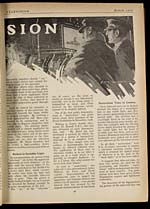John Logie Baird (1888-1946)
Noctovision : seeing in total darkness by television
TELEVISION
MARCH 1928
[NLS note: a graphic appears here – see image of page]
immensely sensitive electric “eye”
which might detect rays outside the
human range of the spectrum.
His first efforts were directed in
the region of ultra-violet rays, above
the visible band of the spectrum, but
these had a most unpleasant effect
upon the skin of those subjected to
them, and, further, they proved to
have little penetrative power through
air.
Next he turned his attention to
another region of the spectrum, the
infra-red beneath the range visible
to human eyesight. By evolving a
fresh light-sensitive cell these rays
proved to be satisfactory, and he
was able to dispense altogether with
visible light. The ordinary photo-
electric cell is almost unaffected by
the infra-red rays, being chiefly acted
upon by the violet end of the spec-
trum. The bolometer or the ther-
mopile are too slow for television
purposes. Mr. Baird, therefore, had
to evolve a light-sensitive device
sensitive to infra-red rays and without
inertia.
Bathed in Invisible Light.
In demonstrations the person being
“televised” sits before the apparatus
apparently in total darkness; at the
same time the normal lights of the
room are switched on but shielded by
a secret light filter, which extracts
all visible rays from the light and
only allows the invisible infra-red
rays to pass. Thus the person is
really bathed in light, but as it cannot
be detected by human eyesight he
is quite unconscious of the fact.
The “eye” of the “televisor”
can, of course, see the scene as
clearly as though it was illuminated
normally, and so the living image is
transmitted as usual, and when
received on the television screen
appears to be brightly lighted.
One of the first public demonstra-
tions of “noctovision” was given
before about forty members of the
Royal Institution in December, 1926.
Writing in Nature shortly after-
wards, Dr. Russell, F.R.S., who had
also witnessed an early demonstra-
tion, said: “Mr. Baird has now
developed a method by which the
image of a person is transmitted,
although he is in complete dark-
ness. . . . These images were not
outlines or shadowgraphs, but real
images by diffused reflected rays.
The application of these rays to
television enables us to see what is
going on in a room which is ap-
parently in complete darkness. So
far as I know, this achievement has
never been done before.”
As soon as “noctovision” was
achieved it was demonstrated before
Military, Air Force, and Naval
experts. Representatives of four
governments came to inspect the
apparatus, and immense interest was
aroused in all quarters—even greater
interest than was aroused by the
original demonstrations of television.
Noctovision Tests in London.
These infra-red rays can be flashed
through the lenses of a searchlight
just as any visible light, and they
have greater penetrating powers than
normal light. The inventor had a
searchlight fitted on the roof of his
London laboratory some months ago.
This was equipped with the filtering
device which retarded the passage of
the visible light, but the beam of
invisible rays was there, and on test
Nelson’s Monument and other London
landmarks were picked out in dark-
ness and seen on the television screen.
In all these “noctovision” tests
it is, of course, necessary to employ
a television receiving screen, upon
which is revealed the lighted image
of whatever is in the path of the
“black light,” as it has been called.
It happens that infra-red rays, by
their very nature, are ideal for fog
penetration, and therefore “nocto-
vision” will be an important develop-
ment in these respects. Fog pene-
tration tests have been given before
illumination experts and lighthouse
authorities.
The discovery of the fog-penetrat-
ing powers of the infra-red rays was
41


